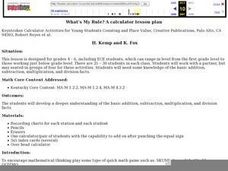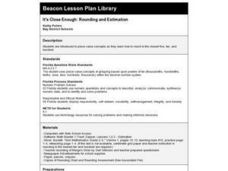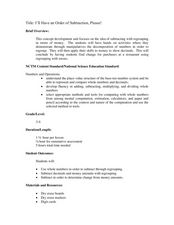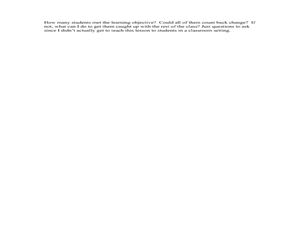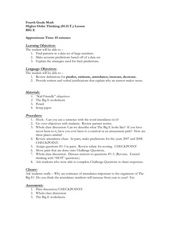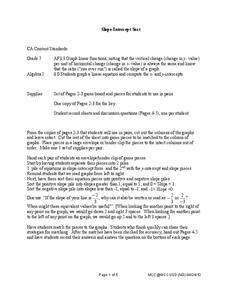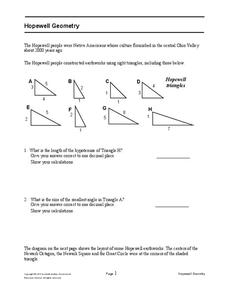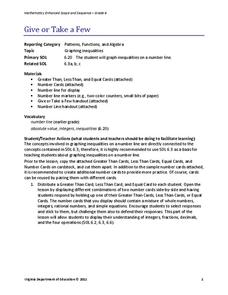Teach Engineering
About Accuracy and Approximation
How accurate are robots? Groups draw lines by moving robots backwards and forwards by one rotation of the wheels. Using the appropriate formula, they determine the percent error in the length of the lines in relation to the calculated...
Bowland
Fruit Pies
Scholars use formulas for the area of a circle and the area of a rectangle to determine the number of pies a baker can make from a particular area of dough. They must also take into account rolling the remaining dough into a new sheet.
Curated OER
Calculators
Students investigate the four basic operations of mathematics that are addition, subtraction, multiplication, and division. The use of a technology game is part of the lesson. They demonstrate the proper use of a calculator as part of...
Curated OER
Hula Hoop Hullabaloo
Second graders use hula hoops to represent the zero as they count objects into ones, tens, hundreds and thousands. They complete an activity to after they have practiced counting objects.
Curated OER
It's Close Enough: Rounding and Estimation
Second graders round to the closest five, ten, and hundred. They use place-value concepts of grouping based upon powers of ten (thousandths, hundredths, tenths, ones, tens, hundreds, thousands) within the decimal number system.
Curated OER
I'll Have an Order of Subtraction Please!
Students explore number values by completing consumer math worksheets. In this math functions lesson, students identify the use of a decimal in numbers and the place values that are represented when dealing with money. Students complete...
Curated OER
Do You Value That Digit?
Sixth graders explore the term digit using large number and comma cards as they create numbers. In this digit value lesson, 6th graders identify the value of digits in large numbers and receive additional practice with the new terms to...
Curated OER
Money Game
Fourth graders give change of one dollar. In this decimal and fractions lesson, 4th graders receive fake coins and discuss what they could purchase with them. Students go for a walk and spend one dollar and get their purchase if they...
Curated OER
Higher Order Thinking (H.O.T.) Lesson - BIG E
Fourth graders work with patterns while using large numbers. In this patterning lesson, 4th graders go over the definitions of the words: predict, estimate, attendance, increase, and decrease. They complete worksheets in which they track...
Virginia Department of Education
Ordering Fractions, Decimals, and Percents
Order up a resource on comparing rational numbers. Scholars order fractions, decimals, and percents by converting to a single form. They conduct a cut-and-paste activity ordering three sets of rational numbers.
West Contra Costa Unified School District
Slope-Intercept Sort
What's so special about slope? Pupils first match cards with slope and y-intercept to graphs of linear equations. They continue the lesson by matching equations in slope-intercept form to the same graphs.
Curated OER
Coin Carnival
Learners investigate the value of coins. In this coin value lesson, students read The Penny Pot by Stuart Murphy. Learners expand on skills learned in the book and engage in activities to determine the value of a mixed set of coins while...
Ohio Department of Education
Fraction and Decimal Equivalency
Mathematicians make representations of fractional parts of a whole and learn that a decimal is another way to represent a fractional part. Understanding is extended by comparing and ordering fractions and decimals on a number line. This...
Helping with Math
Multiplication: 2-digit x 2-digit
Number crunchers sharpen their math skills as they solve 30 problems requiring them to multiply two-digit numbers by two-digit numbers. Assign this as homework or use it as an assessment after practicing the skill together in class.
Curated OER
Million Dollar Project
Students calculate how they will spend a million dollars. In this millionaire math lesson, students complete a worksheet and then make a poster of how they would spend a million dollars. Each item and its cost must be shown. a minimum...
Mathematics Assessment Project
Hopewell Geometry
Right triangles from 2,000 years ago? Learners investigate different right triangles found in the earthworks of the Hopewell people, a Native American culture that populated the United States from 200BC to AD 500. Learners apply concepts...
Curated OER
Bar Graphs
Third graders examine the main parts of a bar graph and how to round up to the nearest tenth. They make an example of a bar graph and answer questions based on the graph using a list of state capitals and their average temperatures....
Curated OER
Circles-Diameter, Circumference, Radius and the Discovery of Pi
Seventh graders measure the diameter, circumference and radius of a circle and find pi using the diameter and circumference. In this geometry lesson, 7th graders work in groups to find the diameter, radius, and circumference of circles....
Curated OER
The Candy Conundrum
Students design a candy container that contains a specific amount of candy. They demonstrate how an engineering problem can be solved with math and that there are multiple answers to the problem. They compute volume of spheres.
Curated OER
Shopping Around
Third graders select a recipe and compare prices for ingredients at two different stores. They select the best place to buy the ingredients and answer questions about the process. They include their data on a spreadsheet related to their...
Curated OER
Mental Methods
In this mental methods instructional activity, students determine the correct answer when multiplying fractions, percents and decimals. They use mental math to solve problems.
National Security Agency
Borrowing from Our Neighbors
Young mathematicians explore two-digit subtraction. They will investigate multiple ways to subtract numbers involving regrouping. Resources are provided.
Curated OER
Percents: What's the Use?
Learners explore percentages in real world situations. In this percents lesson, students determine the final sales price after discounts. Learners interview community members and determine how percentages are used in the real world.
Virginia Department of Education
Give or Take a Few
Young mathematicians extend their knowledge of rational numbers on a number line to graph inequalities by first using number cards to compare rational numbers. They finish by using similar reasoning to graph inequalities on a number line.




